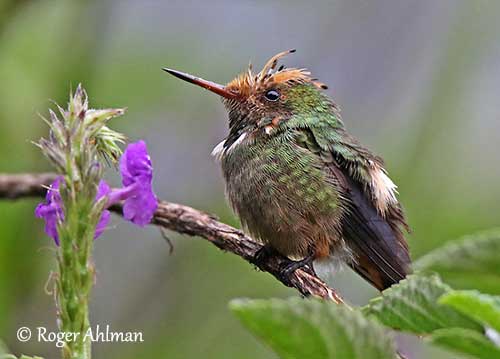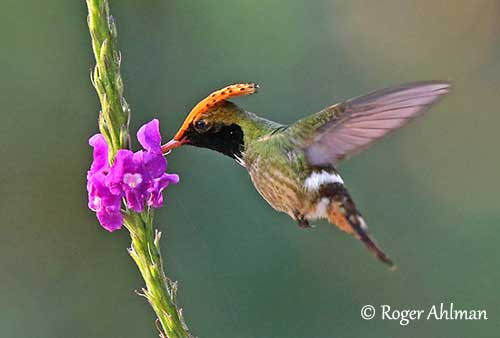
Fr: Coquette pailletée
Ang: Spangled Coquette
All: Glanzelfe
Esp: Coqueta Coronada
Ita: Coquette picchiettata
Nd: Roodkuifkoketkolibrie
Sd: paljettkokett
Photographer:
Roger Ahlman
Pbase Galleries Peru and Ecuador & My bird pictures on IBC
Texte de Nicole Bouglouan
Sources:
HANDBOOK OF THE BIRDS OF THE WORLD Vol 5 by Josep del Hoyo-Andrew Elliott-Jordi Sargatal - Lynx Edicions - ISBN: 8487334253
A GUIDE TO THE BIRDS OF COLOMBIA by Steven L. Hilty and William L. Brown - Princeton University Press – ISBN 069108372X
BIRDS OF VENEZUELA by Steven L. Hilty – Ed. Christopher Helm – ISBN: 0713664185
BIRDS OF PERU by Thomas S. Schulenberg, Douglas F. Stotz, Daniel F. Lane, John P. O’Neill, Theodore A. Parker III – Princeton University Press 2007 - ISBN: 978-0-691-13023-1
Neotropical Birds – Cornell Lab of Ornithology
Spangled Coquette
Lophornis stictolophus
Apodiformes Order – Trochilidae Family
INTRODUCTION:
The Spangled Coquette is a tiny hummingbird that often occurs in the canopy of large flowering trees, perched high in the outer part of the foliage. The male shows a conspicuous rufous crest, and both adults have a typical white band on the rump, well visible in flight.
This species occurs in Venezuela, Colombia, Ecuador and Peru where it frequents woodland edges and drier scrubby areas. It is considered rare and patchily distributed, but currently, it is not globally threatened.
DESCRIPTION OF THE BIRD:
Biometrics:
Length: 6,4 – 6,9 cm
The Spangled Coquette has golden green to bronze green upperparts, with white band across the rump. The lower rump and the uppertail-coverts are purplish-bronze. The tail is cinnamon-rufous with green central pair of rectrices, and all feathers have dark subterminal band and rufous tips. On the wings, the flight-feathers are greyish-black.
On the underparts, the throat is glittering green but the cheek tufts are rufous with broad, iridescent green band. We can see some white pointed feathers on the throat. Rest of underparts are olive green with white vent. The tail is rufous with dark tips.

On the head, forehead and crest are rufous. The bushy crest is finely spotted and tipped black. The glittering green face and throat often appear blackish in the field.
The short, straight bill is red with black tip. The eyes are dark brown. Legs and feet are black.
The adult female lacks both crest and cheek tufts, and her forehead is duller rufous. The upperparts are like in male. She has whitish throat with large rufous spots.
On the underparts, the belly is cinnamon with some scattered green discs. The tail is cinnamon basally, with green central pair of rectrices, but all feathers have black subterminal band and buff tips.
The immature resembles female but it has greyish throat.
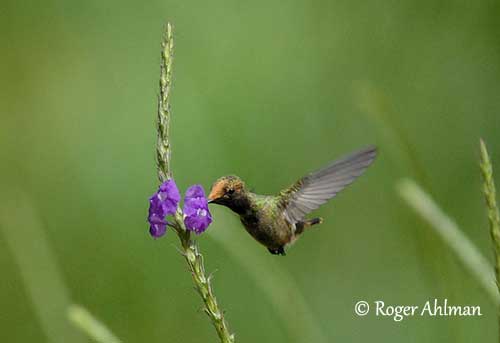
RANGE:
The Spangled Coquette is found in W Venezuela, on the W coastal region and locally in the Andes, then S through E Colombia and E Ecuador to N Peru (Marañon Valley).
HABITAT:
The Spangled Coquette frequents humid foothills forest borders and clearings, but it also occurs in drier scrubby areas, up to 1,300 metres of elevation.
CALLS AND SONGS: SOUNDS BY XENO-CANTO
The Spangled Coquette is mostly silent, but while feeding, it gives sharp, high-pitched « tsip ». When the bird is hovering, the wings produce a low, humming sound.
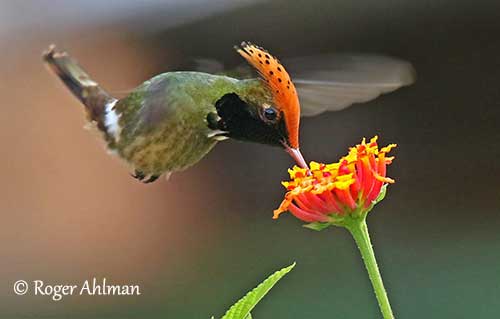
BEHAVIOUR IN THE WILD:
The Spangled Coquette typically feeds on nectar from flowers of several species such as Inga, Lantana, Verbenaceae and Myrtaceae. It is usually seen in the canopy of large flowering trees in foothills.
It is known for stealing nectar from flower territory of larger hummingbirds. It frequents inconspicuous locations within their territory, in order to avoid the owners. It forages until chased away.
It may also glean tiny insects and spiders caught along bare twigs, or it catches insects in the air by hawking.
The breeding behaviour of the Spangled Coquette is unknown, but we can suggest that the bushy crest of the male is raised during display. Throat and rump feathers are raised too, the latter to show off the white band.
It probably sings too, and its iridescent plumage is enhanced by adapted postures. Males are generally polygamous.
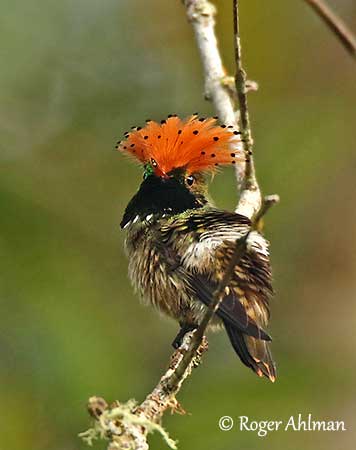
The Spangled Coquette is sedentary in its range.
It has a floating flight, looking as if it is suspended by a string. When feeding at flower trees, it can be mistaken for a large bee.
REPRODUCTION OF THIS SPECIES:
Information on breeding behaviour is currently not available.
However, the Trochilidae usually build a tiny cup-shaped nest placed in trees at various heights, depending on the species. The female lays two white eggs and the incubation lasts about 16-19 days.
The female builds the nest, incubates the eggs and rears the chicks alone. The hummingbirds of genus Lophornis usually produce a single brood per season.
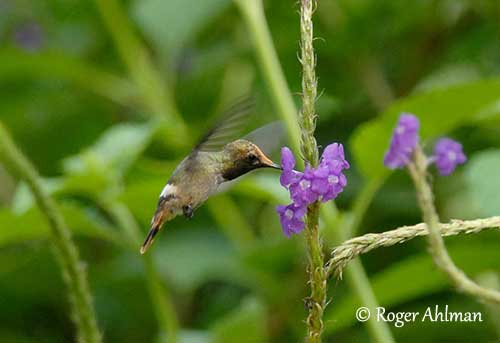
PROTECTION / THREATS / STATUS:
The Spangled Coquette is usually rare, but it may tolerate man-made habitats to some extent. The specie’s is threatened by habitat loss through deforestation.
The population is patchily distributed and suspected to be declining, but currently, the Spangled Coquette is not globally threatened and evaluated as Least Concern.
